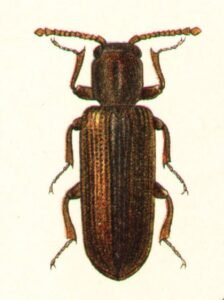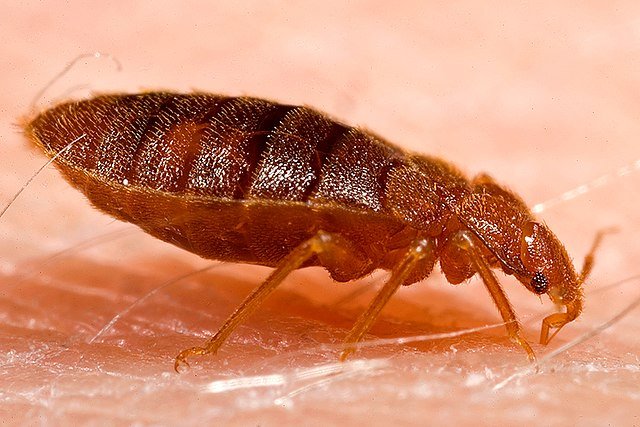Powderpost Beetles (Lyctinae, Bostrichidae, Anobiidae): Identification, Damage & Control
 The Powderpost Beetles are a group of wood-boring insects notorious for reducing solid timber to fine, flour-like powder. Unlike textile pests such as the Carpet Beetle (Anthrenus spp.) or pantry invaders like the Cigarette Beetle (Lasioderma serricorne), powderpost beetles feed directly on wood and wooden products, making them a structural threat in homes, furniture, and even historic artifacts.
The Powderpost Beetles are a group of wood-boring insects notorious for reducing solid timber to fine, flour-like powder. Unlike textile pests such as the Carpet Beetle (Anthrenus spp.) or pantry invaders like the Cigarette Beetle (Lasioderma serricorne), powderpost beetles feed directly on wood and wooden products, making them a structural threat in homes, furniture, and even historic artifacts.
What sets them apart is their ability to live unseen inside timber for months or years. By the time the tiny exit holes appear, the damage inside can be extensive. This slow, hidden destruction often makes people confuse them with Termites, although the biology and signs are very different.
This guide explores their identification, biology, risks, and the best strategies for prevention and control—both at home and in professional pest management.
Identification
Powderpost beetles are not a single species but a category of beetles from several families:
Lyctinae (true powderpost beetles): Attack hardwoods like oak, ash, and walnut.
Bostrichidae (false powderpost beetles): Attack a wider range, including bamboo and softwoods.
Anobiidae (furniture beetles / deathwatch beetles): Common in Europe; target both hardwood and softwood.
Key features:
Adults: Small, 2–7 mm long, elongated, brown to black.
Larvae: Cream-colored, C-shaped grubs that tunnel inside wood.
Exit holes: Round, 1–3 mm in diameter.
Frass (wood dust): Fine, talc-like powder that sifts out of holes—a telltale sign of infestation.
Biology and Lifecycle
Eggs: Females lay eggs in cracks, pores, or unfinished wood surfaces.
Larvae: Bore deep into the wood, feeding on starches within cell walls.
Pupal stage: Develop inside galleries, emerging as adults through exit holes.
Cycle length: 6 months to 5 years, depending on wood type, temperature, and humidity.
This long, variable lifecycle makes infestations difficult to detect and predict.
Ecology and Distribution
Found worldwide, especially in warm, humid regions.
Common in stored lumber, hardwood flooring, furniture, tool handles, and antiques.
Thrive indoors where moisture is elevated and wood is unfinished or untreated.
Lyctid beetles prefer open-grained hardwoods (oak, ash), while anobiids may infest structural timbers in old houses.
Damage and Risks
Structural damage: Flooring, beams, joists, and paneling weakened over time.
Furniture: Antique chairs, tables, and cabinets are frequent victims.
Tools and artifacts: Handles, carvings, and wooden instruments at risk.
Powder production: Fine frass accumulates under infested wood, often mistaken for sawdust.
Economic impact: Billions annually in damage and restoration worldwide.
Compared to Silverfish or Booklice, which nibble at surface materials, powderpost beetles hollow out the wood from within, making them far more destructive in the long term.
Signs of Infestation
Pin-sized round exit holes in wood surfaces.
Piles of fine powder beneath furniture or flooring.
Damaged, weakened timber that crumbles under pressure.
Adult beetles sometimes seen crawling near windows in spring.
Tapping sounds at night in severe infestations (deathwatch beetles).
Household Control Strategies
1. Prevention
Use kiln-dried and properly treated lumber.
Seal unfinished wood with paint, varnish, or wax to prevent egg-laying.
Store firewood outside, not indoors.
2. Environmental Control
Maintain low humidity (< 13% wood moisture content).
Use dehumidifiers in basements and crawl spaces.
3. DIY Treatments
Remove and replace severely infested wood.
Apply borate-based wood preservatives to unfinished surfaces.
Freezing small infested items can kill larvae.
Professional and Long-Term Control
1. Inspection and Monitoring
Professionals identify species, wood type, and infestation severity.
Monitoring includes checking for new frass and fresh exit holes.
2. Targeted Treatments
Surface application of residual insecticides on unfinished wood.
Borate treatments penetrate wood to kill larvae and prevent reinfestation.
3. Fumigation
Whole-structure fumigation may be required for severe infestations.
Effective but costly, used for museums, warehouses, and heritage buildings.
4. Heat Treatment
Exposing wood to temperatures above 50 °C kills eggs, larvae, and adults.
Common in industrial and museum settings.
Comparisons with Similar Pests
Termites: Eat cellulose continuously and destroy wood structurally; powderpost beetles leave frass and distinct exit holes.
Carpet Beetles (Anthrenus spp.): Attack fabrics, not wood.
Drugstore Beetles (Stegobium paniceum) and Cigarette Beetles (Lasioderma serricorne): Infest stored food products, not timber.
Case-Bearing Clothes Moth (Tinea pellionella): Targets wool and textiles, never wood.
Final Thoughts
The Powderpost Beetle is one of the most destructive wood-infesting pests worldwide. Unlike surface feeders such as Silverfish or Booklice, powderpost beetles tunnel deeply into timber, leaving behind only exit holes and fine powder. This hidden lifestyle makes them especially dangerous—structural beams, antique furniture, or hardwood floors can be hollowed out before homeowners notice the problem.
The best protection is prevention: using kiln-dried wood, sealing exposed surfaces, and controlling indoor humidity. Once established, infestations are difficult to eliminate without professional help. While small items can be frozen or treated with borates, serious infestations in homes often require fumigation or heat treatments carried out by certified pest management companies.
Whether in a modern home or a centuries-old heritage building, ignoring the early signs of powderpost beetles can lead to extensive—and costly—damage.
FAQs About Powderpost Beetles
Q: How do I know if I have powderpost beetles or termites?
A: Powderpost beetles leave small, round exit holes with fine, talc-like powder. Termites create mud tubes and do not produce powdery frass.
Q: Can powderpost beetles spread from one piece of furniture to another?
A: Yes. Adults can lay eggs on unfinished or exposed wood surfaces nearby, spreading infestations.
Q: Do they attack painted or sealed wood?
A: Rarely. Finished wood is generally safe, as females cannot lay eggs on sealed surfaces.
Q: Can DIY sprays kill them inside the wood?
A: Most sprays do not penetrate deep enough to reach larvae. Professional borate treatments or fumigation are more reliable.
Q: How long can they live in wood?
A: Depending on conditions, larvae can survive and feed inside timber for 1–5 years before emerging.
Disclaimer
This article is for informational purposes only. Pest control laws and approved chemicals vary by country. For best results and legal safety, we strongly recommend contacting a licensed pest control professional in your local area. Always make sure that the pest control technician is properly certified or licensed, depending on your country’s regulations. It’s important to confirm that they only use approved products and apply them exactly as instructed on the product label. In most places in Europe, UK, or USA, following label directions is not just best practice—it’s the law.
Author
Nasos Iliopoulos
MSc Agronomist & Certified Pest Control Expert
Scientific Director, Advance Services (Athens, Greece)
Licensed Pest Control Business – Ministry of Rural Development & Food (GR)
References
Wikipedia – Powderpost Beetles
Penn State Extension – Powderpost Beetles

